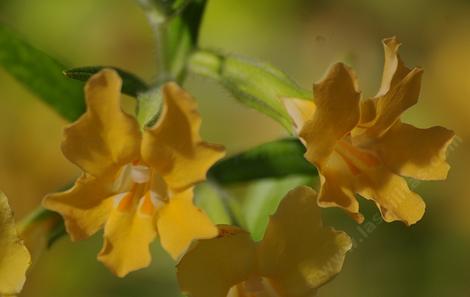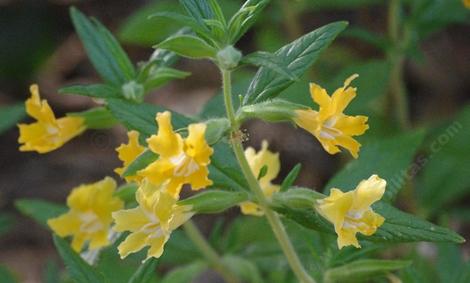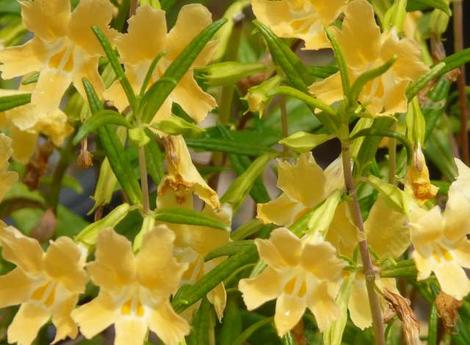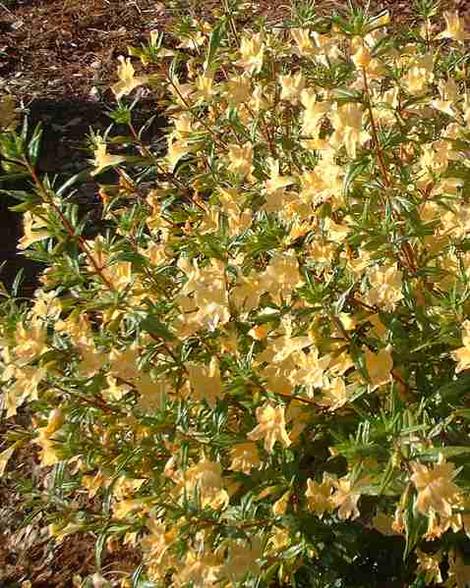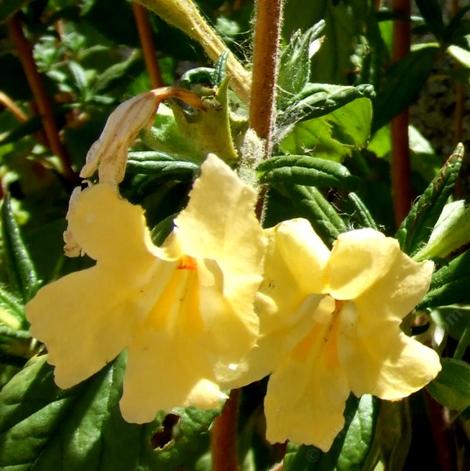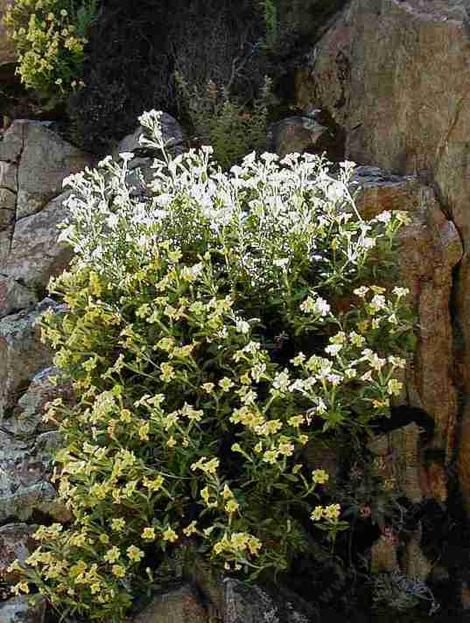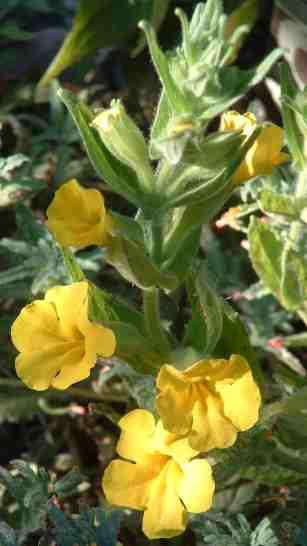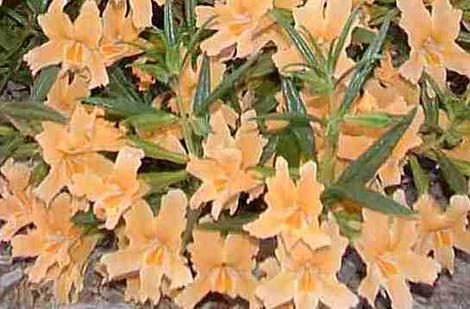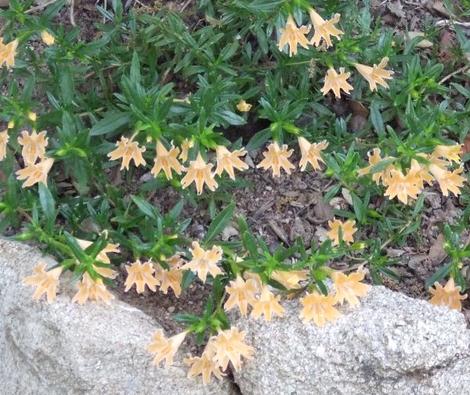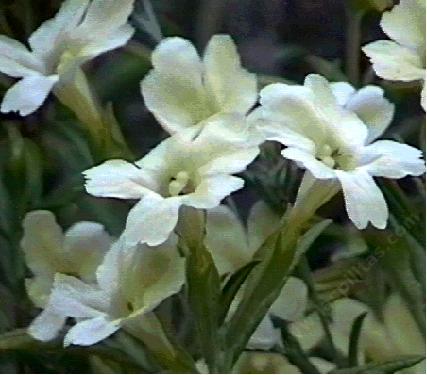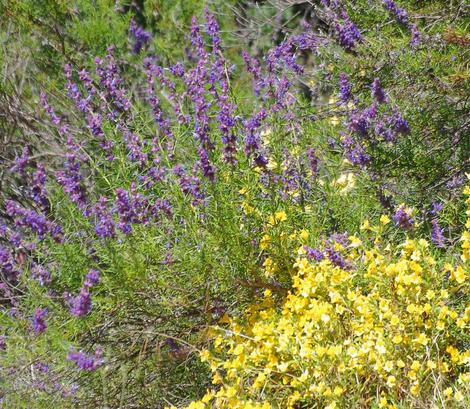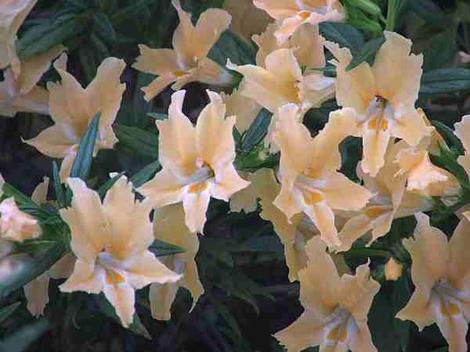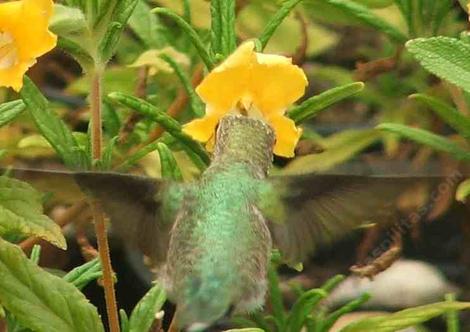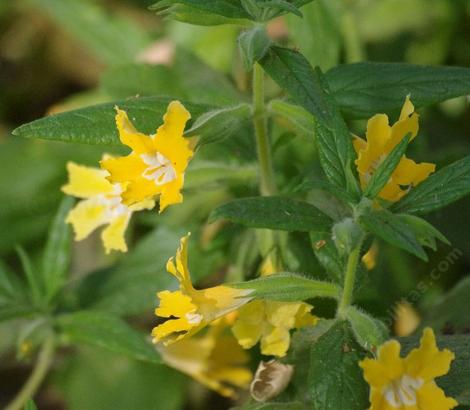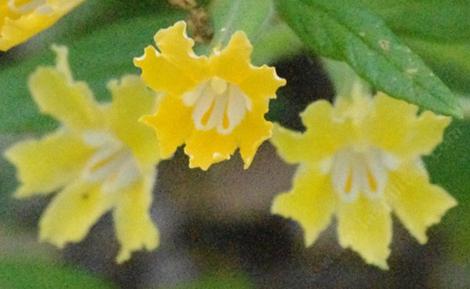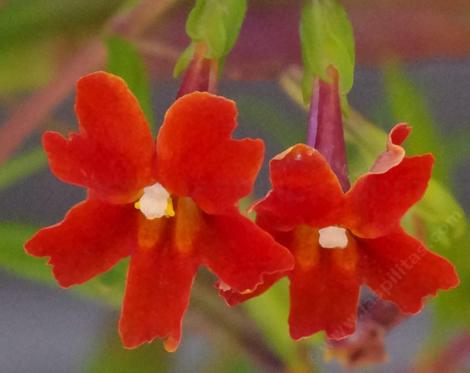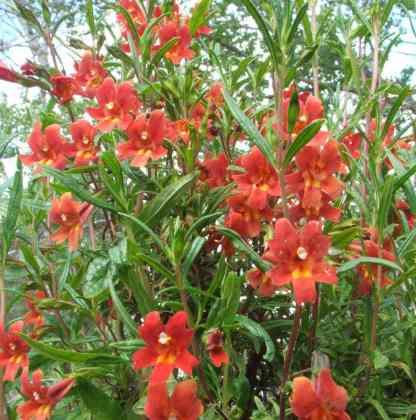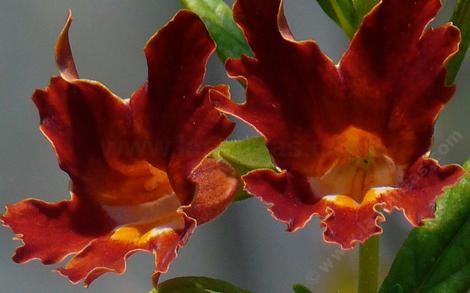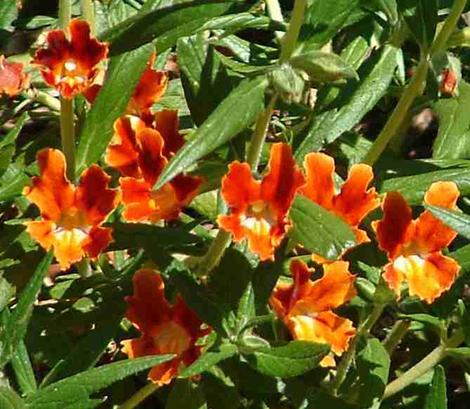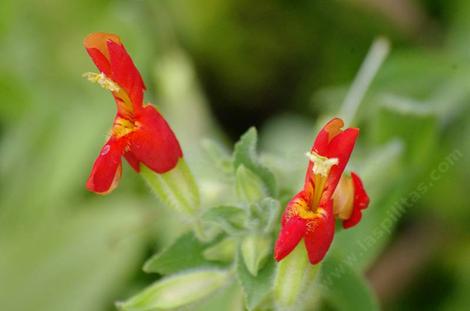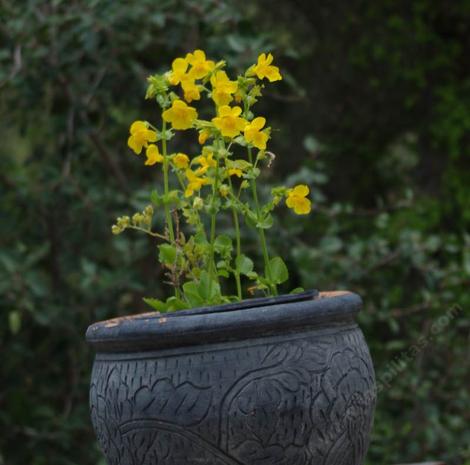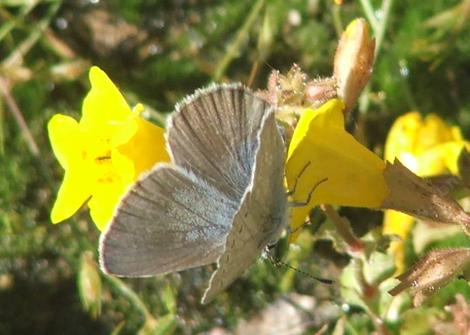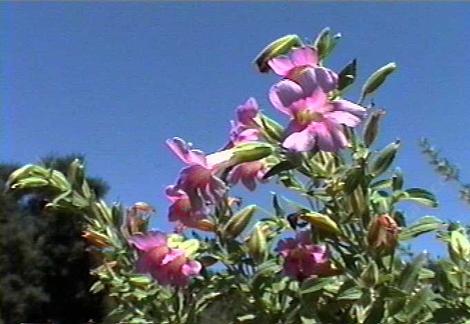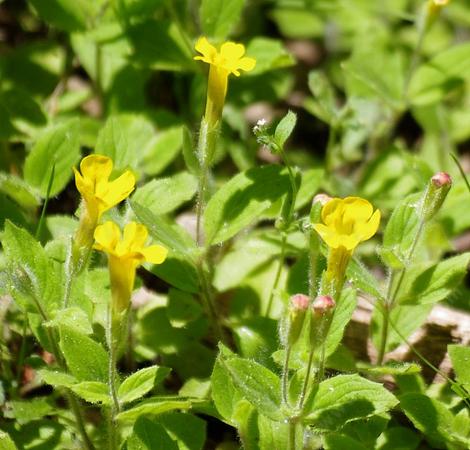California Monkey flowers
These plants are named for their funny-face-flowers that look like grinning Monkeys. The genus Mimulus is named for the Latin mimus, a comic actor or mime. We have left the two genera, Mimulus and Diplacus, separate for ecological reasons. The two may be similar taxonomically but there is a clear difference in their plant community requirements. The flowers in the genus Mimulus like moist areas in riparian corridors and aren't very drought tolerant. Some Mimulus species are annuals that appear only when there is a source of constant moisture, seasonal creaks, seeps, ponds etc. Mimulus species are more herbaceous and often shorter. On the other hand, plants in the Genus Diplacus like dry rocky slopes. They can often be found growing in almost solid rock with very little moisture even on south facing slopes. They will often survive drought by going summer deciduous. Diplacus species are erect and woody in their growth habit. Monkey flowers are more floriferous in full sun but will tolerate part or even full shade.California Diplacus species
These guys are general drought tolerant woody perennials that go summer deciduous under stress. (McMinn separated them from Mimulus in the late thirties, and I've keep the nomenclature.)Diplacus aurantiacus, Orange Bush Monkey Flower
Orange bush Monkey flower is cold tolerant to 12-15 deg. It can grow in any soil including serpentine but needs some drainage. Don't over water! The Jepson manual lumps all the monkey flowers into this species, aurantiacus, under the Genus Mimulus. Munz puts them in different species but all under the same genus Mimulus. We prefer to keep them separate (as does the synthesis of the North American flora, the Integrated Taxonomic Information System, and ). This wide ranging monkey flower can be found in the coast ranges from Santa Barbra to Del Norte County and in the foothills of the Sierras from Del Norte to Tuolumne county in the following plant communities: Chaparral, Closed-cone Pine Forest, Central Oak Woodland, Coastal Sage Scrub, Mixed-evergreen Forest, Northern Coastal Sage Scrub, Northern Oak Woodland, Redwood Forest.
Diplacus aurantiacus, Sierra Monkey Flower
This cultivar of orange bush monkey flower is a little nicer that the general form. If you live in the sierras this form would be preferable. It also does well in the coast ranges. It especially likes Decomposed granite soil.
The Sierra soils are very acidic and many plants from other areas have trouble staying green there.
Diplacus aurantiacus australis Ramona, Narrow Leaf Southern Monkey Flower
This monkey flower flowers like crazy. It, like most monkey flowers, likes rocky outcroppings. Placing a few rocks around them in your garden looks nice and makes them very happy. It is found in southern California in the following plant communities: Coastal Sage Scrub, Southern Oak Woodland. Ramona Monkey flower was growing in a weedy field outside of Ramona. This Monkey Flower; and a few Coast Live oaks were all that was left for acres. It has grown well in beach sand and adobe soil. Part shade or full sun.Diplacus aurantiacus lompocensis, Lompoc Monkey Flower
Lompoc monkey flower is a little lighter orange than the strait aurantiacus. It grows well along the coast as well as inland with a little shade. It grows in southern San Luis Obispo county to western Santa Barbra county around Lompoc. It is found in the Chaparral and Coastal Sage Scrub plant communities.Diplacus calycinus, Rock Monkey Flower
This light yellow monkey flower loves rocky areas. It grows under the protection of boulders or in rocky crevices and rocky outcroppings. This monkey flower is found from Fresno to Kern counties along the base of the sierras and strangely in the interior coast ranges of San Luis Obispo county. It is also found in the San Gabriel mountains to the mountains in north east San Diego county. It is found in these plant communities: chaparral, Central Oak Woodland, Joshua Tree Woodland, and Yellow Pine Forest.
Diplacus clevelandii, Clevelands Monkey flower
This yellow monkey flower is soft like a Mimulus sp but can tolerate drought like a Diplacus sp. The flowers are unique looking Cleveland's Monkey flower is found from the Santa Ana mountains to southern San Diego county in the Mixed-evergreen Forest, and Yellow Pine Forest plant communities.
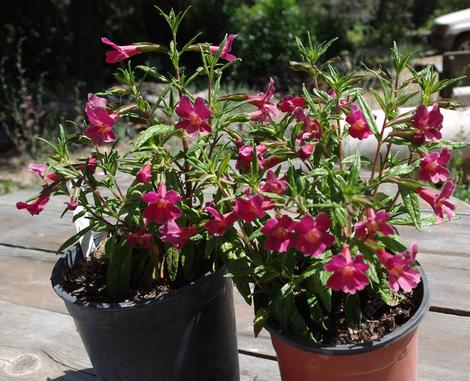
Diplacus grandiflorus, Slender Monkey Flower
This yellowish-orange monkey flower likes rocky slopes with well drained soil but it will tolerate clay. It also tolerates garden conditions if it has well drained soil. It is found in rocky areas in the Santa Lucia mountains of San Luis and Monterey y counties, in the Chaparral,and Central Oak Woodland plant communities it also along the Sierras, in the Yellow Pine Forest plant community. The foliage is a dark shiny green. It seems to prefer a little shade. Deer do not seem to eat any of the Monkey flowers.Diplacus longiflorus, Southern Monkey Flower
This faded yellow monkey flower can look almost white! This is the same monkey flower as in the introduction picture on this page. It likes rock outcroppings and can tolerate full sun on rocky exposed south facing slopes. However it will go summer deciduous under these conditions. You can prevent this by giving it a little summer water. You can also keep it greener by giving it a little shade. Deer aren't interested in it. It likes decomposed granite, and is found in Chaparral, and Coastal Sage Scrub plant communities.Diplacus longiflorus, Agoura Spunky Monkey Flower
This southern California monkey can tolerate very hot dry conditions but it will go summer deciduous. If you give it a little shade and some summer water you can keep it looking green. It flowers a lot and the flowers are fairly large. It likes Chaparral, and Coastal Sage Scrub plant communities.
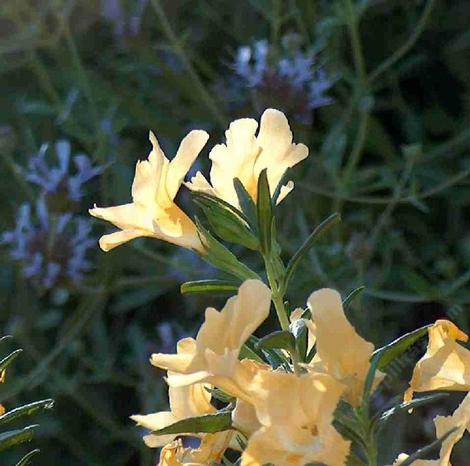
Diplacus longiflorus, Conejo Monkey Flower
This is a yellower D. longiflorus. It is really large for a monkey flower, it can be over 3 ft tall! It likes Chaparral, Coastal Sage Scrub, and Southern Oak Woodland plant communities.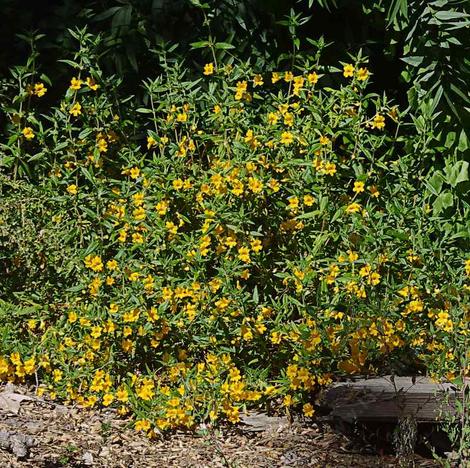
Diplacus longiflorus, Topanga Monkey flower
came from a place in Topanga. It's a Hollywood star.Another D. longiflorus! This one is also from Southern California. This monkey can tolerate full shade well. It likes the Coastal Sage Scrub plant community.
Diplacus puniceus, Red Monkey flower
This southern California Monkey flower is red. It likes well drained soil. It likes part shade inland and full sun along the coast. It is found in the Chaparral, and Coastal Sage Scrub plant communities.
Diplacus rutilus, Santa Susana Monkey Flower
Santa Susana Monkey flower has beautiful brick red flowers and glossy green foliage. This guy is kind of soft so protect it from cold by placing it on the warm side of a structure or under the protection of trees or shrubs if you get hard frosts. It does best in a mild Chaparral plant community. but will work in most of coastal California and the San Joaquin Valley.If this flower was human it would be a lounge singer.
California Mimulus species
These monkey flowers can often be found in moist areas near seeps. Creeks, ponds etc. They are generally herbaceous, some are even annuals.
Mimulus cardinalis, Scarlet Monkey Flower
Scarlet monkey flower has brilliant red-orange flowers. The flowers are large but the petals fold back on themselves. Making them tall and narrow. The foliage is soft and light green. Scarlet monkey likes sunny or shady shaded wet places. It can tolerate garden conditions well but may spread if given excess water. It is best near a dripping birdbath or near a facet. The hummingbirds like it.
Mimulus guttatus, Seep Monkey Flower
Seep monkey likes really wet spots. It has lots of yellow flowers that are popular with bumble bees. It does spread but can't grow where there isn't water. So confine it in a wet spot. It prefers sunny locations.Mimulus lewisii, Monkey Flower
Yes, a this Monkey flower is Pink! This monkey flower does much better at higher elevations. It is confused by are warm days and cold nights. It needs a lot of water. It is would also do well under drippy birdbath.
Mimulus tilingii, Creeping Monkey
Creeping monkey flower kind of resembles Seep monkey flower. It also likes really wet areas. It tolerates flooding well.
There are many other species of Monkey flowers in the state. But most are small annuals that no one carries seed for. So they are great to look at, but do not pick please. Take pictures!

